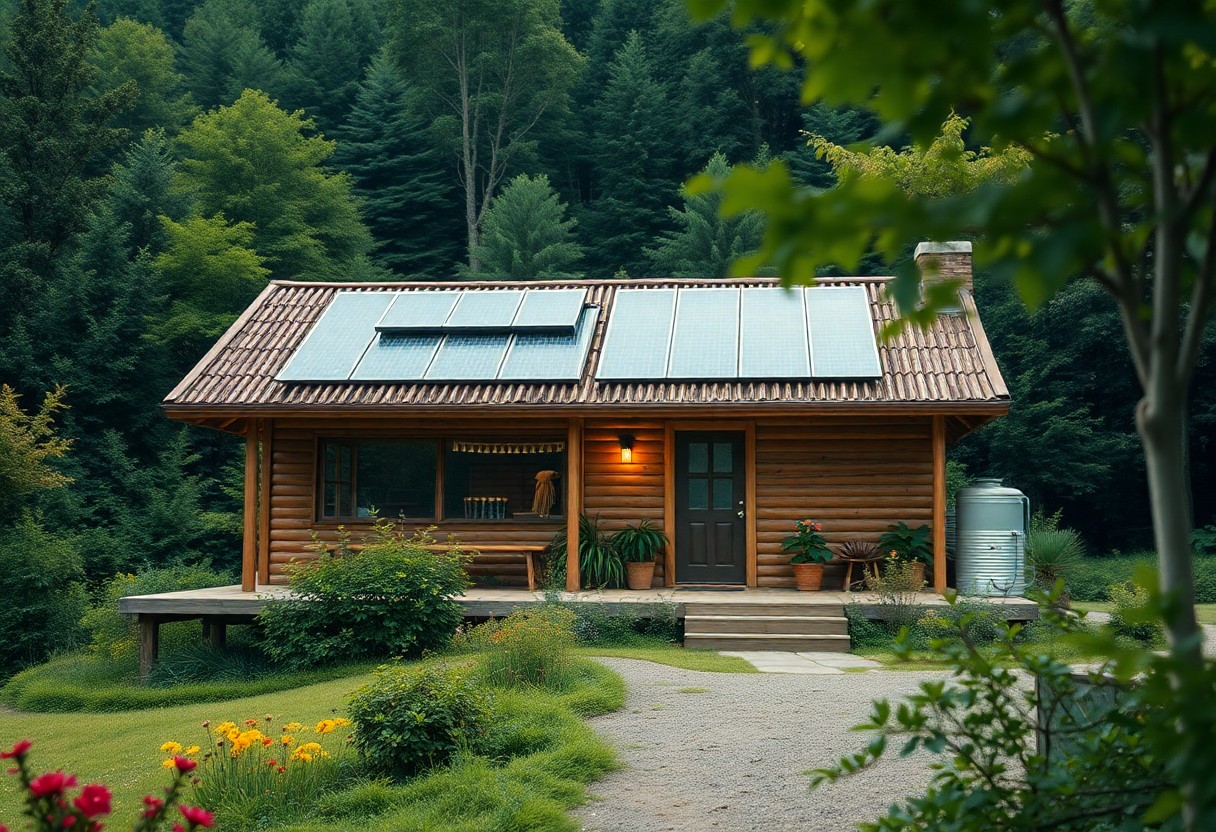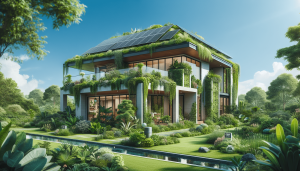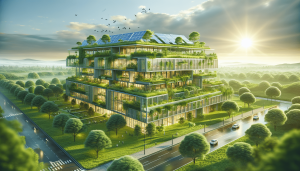Most people dream of a home that harmonizes with nature while minimizing their environmental impact. To achieve this, you can embrace innovative design principles and sustainable materials that promote energy efficiency and resource conservation. In this guide, you’ll learn how to create an eco-friendly off-grid home, allowing you to enjoy the freedom of self-sufficiency while making a positive impact on the planet. Join us as you explore practical steps toward building a sanctuary that reflects your values and respects the Earth’s natural resources.
Key Takeaways:
- Site Selection: Choosing the right location can enhance natural resource use, allowing for better energy efficiency and reduced environmental impact.
- Materials: Utilizing sustainable, local, and reclaimed materials can minimize carbon footprints and support local economies.
- Renewable Energy: Incorporating solar, wind, or other renewable energy sources is imperative for achieving true off-grid living, enabling self-sufficiency and resilience.
How to Choose an Eco-Friendly Site
A key factor in designing and building your eco-friendly off-grid home is selecting the right site. Consider the natural landscape, sunlight exposure, wind patterns, and proximity to resources to ensure that your home not only minimizes its environmental footprint but also maximizes efficiency and comfort.
Evaluating Environmental Impact
There’s a significant need to assess the potential environmental impact of your chosen site. Consider the flora and fauna, as well as any nearby water sources, to avoid disrupting local ecosystems. By prioritizing biodiversity and adhering to local environmental regulations, you can build a sustainable home that coexists harmoniously with nature.
Access to Resources
There’s a practical aspect to consider when choosing your site: access to vital resources. Having reliable access to water, wood for heating, and edible landscapes can greatly enhance your ability to live off the grid and maintain a self-sufficient lifestyle.
It’s vital to evaluate your site’s proximity to water sources, as clean water is vital for drinking and irrigation. Look for areas with abundant natural vegetation to provide wood for fuel and possible food sources. Additionally, assess the availability of materials for construction, ensuring that you can source locally to reduce your carbon footprint. Access to renewable energy options, like solar or wind, can further enhance your off-grid living experience, reinforcing the importance of making informed decisions about your site.

How to Design Your Off-Grid Home
Any off-grid home design begins with understanding your unique needs and the environment in which you’ll be building. You want to create a living space that not only harmonizes with nature but also maximizes efficiency—ensuring you use resources wisely. Consider factors like location, climate, and local regulations, while also emphasizing sustainability throughout the blueprint. A thoughtful design process will ultimately yield a comfortable, eco-friendly sanctuary tailored specifically to your lifestyle.
Utilizing Sustainable Materials
There’s a vast array of sustainable materials available for your off-grid home, each contributing to a reduced environmental impact. Consider using reclaimed wood, bamboo, or straw bales, which are not only eco-friendly but also often more affordable than traditional materials. Additionally, recycled steel and concrete can enhance durability while minimizing waste. By carefully selecting materials, you ensure your home is sustainable, energy-efficient, and harmonious with its surroundings.
Energy-Efficient Layouts
EnergyEfficient layouts play a vital role in maximizing the functionality of your off-grid home. By designing your space with natural light, orientation, and ventilation in mind, you can significantly reduce energy consumption. Adaptive thermal management will keep your home comfortable regardless of the season, while spacious open designs allow heat to circulate more effectively. You should also consider allowing for solar energy integration and renewable energy systems, as these elements are crucial for creating a self-sustaining environment.
Your goal with energy-efficient layouts is to create a home that minimizes reliance on external power sources while optimizing comfort and functionality. Prioritize strategically placed windows to harness natural light and create cross-ventilation, reducing heating and cooling demands. Incorporate thermal mass elements, like concrete or stone, to absorb heat during the day and release it at night, creating a stable indoor climate. Pay attention to the flow of living spaces, ensuring rooms are designed for intuitive energy use that aligns with your daily routines. By focusing on these aspects, you’ll create an off-grid home that is not only sustainable but also a joy to live in.
How to Incorporate Renewable Energy Sources
After choosing an eco-friendly off-grid location, the next step is to incorporate renewable energy sources that align with your needs. By harnessing natural resources, you can minimize your environmental footprint while ensuring a sustainable energy supply for your home. Evaluate your energy consumption habits and local resources to determine the best renewable energy solutions for your situation.
Solar Power Solutions
For many off-grid homes, solar energy is an ideal choice due to its accessibility and adaptability. Installing solar panels allows you to generate electricity from sunlight, which can power everything from lights to appliances seamlessly. Consider integrating battery storage systems to capture excess energy for use during cloudy days or nighttime.
Wind Energy Options
Assuming you have adequate wind resources in your area, wind energy can be an effective supplement to your renewable energy system. Small wind turbines can be installed to harness the wind’s power, providing a consistent energy source when conditions are right.
To maximize the benefits of wind energy, evaluate your site for its wind speed and consistency. If your location averages at least five meters per second, installing a small wind turbine could generate a significant portion of your energy needs. It’s important to maintain a safe distance from trees and buildings, as they can cause turbulence and reduce efficiency. Properly sizing your turbine in relation to your power demands ensures you capitalize on this clean energy source, while reducing your reliance on fossil fuels.
Tips for Water Conservation and Management
All homeowners can significantly reduce their water usage with a few intentional practices. Consider these effective tips for water conservation:
- Install low-flow fixtures
- Use drought-resistant plants in landscaping
- Collect rainwater
- Limit outdoor watering to early mornings or late afternoons
- Conduct regular plumbing checks for leaks
After incorporating these strategies, you will notice a marked improvement in your water management efforts.
Rainwater Harvesting Techniques
There’s an abundance of methods for collecting rainwater that can provide a sustainable water source for your off-grid home. Installing a rain barrel or cistern can help capture runoff from your roof, allowing you to store it for irrigation or household use. Make sure to incorporate proper filtration and overflow systems to ensure that you can efficiently manage supplies during dry spells.
Greywater Recycling Systems
Systems that recycle greywater can help you save on water consumption and reduce waste. By reusing water from your sinks, showers, and washing machines, you contribute to a more sustainable lifestyle. These systems often include filtration and treatment methods that allow you to repurpose this water safely.
Management of greywater recycling systems is important for both environmental safety and effectiveness. You need to make sure that your recycled water is free from hazardous substances, using appropriate filters and treatments. These systems not only help conserve water but also lessen the impact of wastewater, effectively reducing your environmental footprint. Proper maintenance and knowledge about local regulations regarding greywater use will ensure your system operates efficiently and safely.
Factors to Consider for Waste Management
Unlike traditional homes that rely on municipal systems, when designing your eco-friendly off-grid home, you must focus on waste management solutions that promote sustainability. Key factors to include are:
- Types of waste generated
- Implementation of composting systems
- Recycling and reuse of materials
- Consideration of hazardous waste disposal
Recognizing these factors will help you create an efficient waste management plan that minimizes your environmental impact.
Composting Toilets
There’s a significant shift towards composting toilets in off-grid homes due to their low water consumption and ability to convert human waste into nutrient-rich soil. These systems not only reduce your environmental footprint but also promote a self-sufficient lifestyle. With proper maintenance, composting toilets can effectively manage waste without the need for connection to a sewage system.
Recycling Systems
Factors to consider when establishing recycling systems in your off-grid home include how to sort your waste and what materials are accepted for recycling. You should aim to create a designated space for containers to segregate paper, plastics, metals, and glass.
A well-implemented recycling system encourages responsible waste disposal, significantly reducing your overall waste output. It’s vital to be aware that improper recycling can lead to contamination of recyclable materials, which can render entire batches unusable. Ceiling items that are marked unsafe for recycling is important as it reduces hazardous waste risks. Positive aspects of recycling include conserving resources and reducing landfill contributions, creating a healthier ecosystem for you and your surroundings.
How to Ensure Year-Round Comfort
Keep your off-grid home comfortable throughout the seasons by focusing on smart design choices. Integrating renewable energy systems, considering the local climate, and selecting the right building materials will create a home that remains cozy in winter and cool during summer. By using a combination of passive and active heating and cooling methods, you can significantly enhance your living experience while reducing energy consumption.
Thermal Mass and Insulation
Insulation is vital for maintaining a stable indoor temperature, regardless of external weather conditions. Using materials with a high thermal mass, such as concrete or stone, allows your home to absorb, store, and gradually release heat, effectively moderating temperature fluctuations. Additionally, ensure your walls, roof, and floors are well-insulated to minimize heat loss during winter and heat gain in summer, ultimately promoting energy efficiency and comfort.
Natural Ventilation Strategies
If you want to enhance air quality and comfort in your off-grid home, consider implementing natural ventilation strategies. This approach takes advantage of prevailing winds, temperature differences, and building orientation to create a flow of fresh air without relying on mechanical systems.
This technique can significantly reduce reliance on artificial cooling and heating methods, translating to energy savings. Utilizing strategically placed windows, ventilation openings, and roof overhangs can facilitate cross-ventilation, allowing cool breezes to flow through your home while effectively pushing out warm air. By fostering this natural airflow, you not only enhance your comfort but also contribute to a healthier indoor environment—ensuring you enjoy your off-grid living experience fully.
To wrap up
Conclusively, designing and building an eco-friendly off-grid home empowers you to lead a sustainable lifestyle while minimizing your environmental impact. By incorporating renewable energy sources, efficient insulation, and resourceful water management, you create a comfortable living space that harmonizes with nature. Consider using locally sourced materials and sustainable practices to enhance your home’s longevity and resilience. As you begin on this journey, you not only invest in your well-being but also contribute positively to the planet for future generations.
FAQ
Q: What materials are best for building an eco-friendly off-grid home?
A: When designing an eco-friendly off-grid home, it’s important to choose sustainable materials that reduce environmental impact. Consider using bamboo, reclaimed wood, straw bales, or compressed earth blocks. These materials are renewable, locally sourced, and often have a lower carbon footprint. Additionally, opting for materials with high thermal mass, like concrete or stone, can help maintain temperature regulation in the home, reducing the need for energy consumption.
Q: How can I ensure my off-grid home is energy efficient?
A: To achieve energy efficiency in your off-grid home, focus on a well-insulated design, which minimizes heat loss in winter and keeps the space cool in summer. Incorporate passive solar design techniques by strategically placing windows to maximize natural lighting and heat from the sun. Installing energy-efficient appliances and LED lighting can further reduce energy consumption. Finally, consider renewable energy sources like solar panels or wind turbines to produce your own electricity sustainably.
Q: What systems should I include for water management in an eco-friendly home?
A: Effective water management systems are crucial for any eco-friendly off-grid home. Rainwater harvesting is a popular method, allowing you to collect and store rainwater for non-potable uses or potable water if properly filtered. Installing greywater recycling systems helps repurpose water from sinks and showers for irrigation or toilet flushing. It’s also beneficial to include a natural filtration system for any onsite well you may have, enhancing sustainability and ensuring clean water access.
Q: What are the benefits of using renewable energy sources in my off-grid home?
A: Utilizing renewable energy sources, such as solar, wind, or hydropower, offers numerous benefits for your off-grid home. These energy sources are sustainable and abundant, reducing reliance on fossil fuels and lowering your carbon footprint. They can also lead to significant cost savings over time due to decreased utility bills and maintenance costs. Furthermore, their use promotes energy independence and self-sufficiency, giving you greater control over your energy needs and reducing vulnerability to energy market fluctuations.
Q: How can I design my off-grid home to be resilient and adaptable to climate change?
A: To create a resilient off-grid home, consider designing with materials and technologies that withstand extreme weather events, such as heavy rainfall, floods, and high winds. Implementing elevated foundations and designing a sloped roof can help manage water runoff. Additionally, prioritize natural ventilation and shading features to reduce heating and cooling costs. Incorporate biodiversity by planting native vegetation around your home to enhance ecological stability and create a habitat for local wildlife. This also aids in soil retention and reduces erosion risks.




